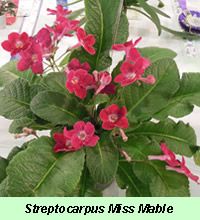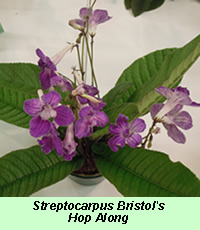Gesneriad Information
STREPTOCARPUS
 The genus Streptocarpus (strep-toe-CAR-pus) was named in 1827 by James Bow, an Englishman. The word streptos means twisted and the word carpus means fruit. Hence twisted fruit. The fruitis are long and skinny and dehisce (open) in a spiral pattern. Streptocarpus are native to Africa. They are divided into two subgenera, Streptocarpus and Streptocarpella. The Streptocarpella include species such as S. holstir. S. saxorum and the variety S. "Good Hope". They are branching herbs with paired leaves. The subgenus Streptocarpus have strap shaped leaves arranged in a rosette. Some species such as S.dunnii have only one trap shaped leaf that may reach three feet in length.
The genus Streptocarpus (strep-toe-CAR-pus) was named in 1827 by James Bow, an Englishman. The word streptos means twisted and the word carpus means fruit. Hence twisted fruit. The fruitis are long and skinny and dehisce (open) in a spiral pattern. Streptocarpus are native to Africa. They are divided into two subgenera, Streptocarpus and Streptocarpella. The Streptocarpella include species such as S. holstir. S. saxorum and the variety S. "Good Hope". They are branching herbs with paired leaves. The subgenus Streptocarpus have strap shaped leaves arranged in a rosette. Some species such as S.dunnii have only one trap shaped leaf that may reach three feet in length.  Subgenus Streptocarpus are shallow rooted and do well in a light soilless mix with lime added. A good mix is 1 1/2 parts peat moss, 1 part perlite, 2 parts vermiculite and 2 tablespoons of lime chips to one quart of soil. Plant in an azalea pot or other shallow pot. They grow best in temperatures between 55° and 75°F. Streptocarpus need to be on a shaded porch with good ventilation to survive the hot St. Louis summers. Water every watering with 1/4 teaspoon of Rapid Gro or other granular fertilizer per gallon of water. To propagate the strap shaped leaves, cut out the midvein and plant each half of the leaf with the cut part buried Slightly in the soil.
Subgenus Streptocarpus are shallow rooted and do well in a light soilless mix with lime added. A good mix is 1 1/2 parts peat moss, 1 part perlite, 2 parts vermiculite and 2 tablespoons of lime chips to one quart of soil. Plant in an azalea pot or other shallow pot. They grow best in temperatures between 55° and 75°F. Streptocarpus need to be on a shaded porch with good ventilation to survive the hot St. Louis summers. Water every watering with 1/4 teaspoon of Rapid Gro or other granular fertilizer per gallon of water. To propagate the strap shaped leaves, cut out the midvein and plant each half of the leaf with the cut part buried Slightly in the soil.Subgenus Streptocarpella do well in a hanging basket or azalea pot. Use the same soilless mix and watering as for the subgenus Streptocarpus. The Streptocarpella can be propagated from tip cuttings.
